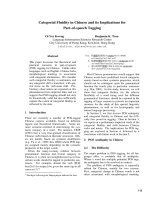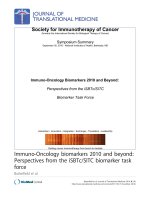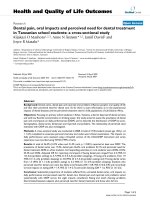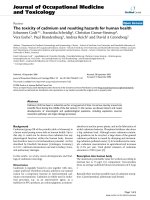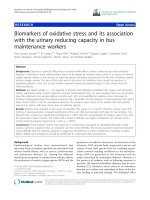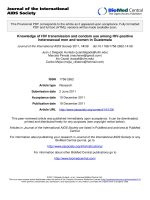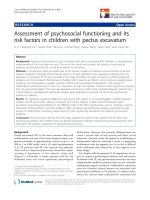Báo cáo hóa học: "Alliinase from Ensifer adhaerens and Its Use for " pot
Bạn đang xem bản rút gọn của tài liệu. Xem và tải ngay bản đầy đủ của tài liệu tại đây (437.03 KB, 8 trang )
ORIGINAL ARTICLE Open Access
Alliinase from Ensifer adhaerens and Its Use for
Generation of Fungicidal Activity
Masahiro Yutani
1
, Hiroko Taniguchi
1
, Hasibagan Borjihan
1
, Akira Ogita
1,2
, Ken-ichi Fujita
1
, Toshio Tanaka
1*
Abstract
AbacteriumEnsifer adhaerens FERM P-19486 with the ability of alliinase production was isolated from a soil
sample. The enzyme was purified for characterization of its general properties and evaluation of its application
in on-site production of allicin-dependent fungicidal activity. The bacterial alliinase was purified 300-fo ld from a
cell-free extract, giv ing rise to a ho mogenous protein band on polyacrylamide gel el ectrophoresis. The bacterial
alliinase (96 kDa) consisted of two identical subunits (48 kDa), and was most active at 60°C and at pH 8.0. The
enzyme stoichiometrically converted (-)-alliin ((-)-S-allyl-L-cysteine sulfoxide) to form allicin, pyruvic acid, and
ammonia more selectively than (+)-alliin, a naturally occurring substrate for plant alliinase ever known. The C-S
lyase activity was also detected with this bacterial enzyme when S-alkyl-L-cysteine was used as a substrate,
though such a lyase activity is absolutely absent in a lliinase of plant origin. The enz yme generated a fun gicidal
activity against Saccharomyces ce revisiae in a time- and a dose-dependent fashion using alliin as a stable
precursor. Alliinase of Ensifer adhaerens FERM P-19486 is the enzyme with a novel type of substrate specificity,
and thus considered to be beneficial when used in combination with garlic enzyme with respect to absolute
conversion of (±)-a lliin to allicin.
Introduction
Allicin (diallyl thiosulfinate, Figure 1a) is the best-known
active compound of freshly crushed garlic extract, and is
known to possess a vast variety of biological effects:
antimicrobial, anti-inflammatory, antithrombotic, antic-
ancer, and antiatherosclerotic activities (Stoll and
Seeback 1951; Block 1985; Tsai et al. 1985; Agarwal
1996; Ankri and Mirelman 1999; Siegel et al. 1999).
This allyl-sulfur compound is synthesized as a result of
condensation of allyl sulfenate, which is produced
depending on the C-S lyase activity of alliinase (EC
4.4.1.4) on (+)-alliin ((+)-S-allyl-L-cysteine sulfoxide), a
naturally occurring diastereomer, as illustrated in Figur e
1a (Siegel et al. 1999; Jones et al. 2004). Alliinase is
therefore distinguished from S-alkyl-L-cysteine lyase (EC
4.4.1.6), which simply exhibits C-S lyase activity as to
produce alkyl mercaptan in addition to pryruvic acid
and ammonia (Figure 1b). Alliinase has been purified
from garlic, onio n, and oth er plants of the genus Allium
(Schwimmer and Mazelis 1963; Mazelis and Crews
1968; Tobkin and Mazelis 1979; Nock and Mazelis
1986; Landshuter et al. 1994; Lohmüller et al. 1994;
Rabinkov et al. 1994; Manabe et al. 1998). The enzy-
matic production of allicin is thou ght to occur in nature
as a result of injury of the plant tissue that enables
interaction of the enzyme in vacuoles with alliin accu-
mulated in the cytosol (Lancaster and Collin 1981).
Therefore, allicin production has been discussed as a
defense mechanism of the plant against microbial infec-
tion or insect attack (Slusarenko et al. 2008).
On-site production of allicin from a stable precursor
alliin is attr active if this can be applied for various
clinical purposes. In fact, with increasing interest in
the efficacy of allicin in the purposes, its production
has been devised both in vitro and in vivo with the aid
of garlic alliinase (Miron et al. 2003; Shadkchan et al.
2004; Fry e t al. 2005). Alliinase from microbial origin
is another choice for this purpose. Murakami (1960)
first reported the occurrence of alliinase in microbial
world based on the detection of the corresponding
enzyme activity in acetone-powdered cell-free extract
from Bacillus subtilis. Durbin and Uchytil (1971) then
reported the production of the enzyme by Penicillium
corymbiferum. The partially purified enzyme
* Correspondence:
1
Department of Biology and Geosciences, Graduate School of Science, Osaka
City University, 3-3-138 Sugimoto, Sumiyoshi-ku, Osaka 558-8585, Japan.
Full list of author information is available at the end of the article
Yutani et al. AMB Express 2011, 1:2
/>© 2011 Yutani et al; licensee Springer. This is a n Open Access article distributed under the terms of the Creative Commons Attrib ution
License (http://creat ivecommons.org/licenses/b y/2. 0), which permits unrestricted use, distribution, and reproduction in any mediu m,
provided the original work is properly cited.
stoichiometrically converted alliin to pyruvic acid,
ammonia, and allicin, showing none of lyase activity
on S-alkyl-L-cysteine. In the present study, we isolated
a microorganism, which generates allicin-like odor
during the growth in medium containing (±)-alliin, and
purified the enzyme involved in the metabolic conver-
sion of this amino acid derivative into an odorous
compound. We hereby report isolation of an al liinase-
producing bacterium, purification of the bacterial
enzyme, and its substrate specificity characterized by
the selectivity toward (-)-alliin. We also evaluate a
combination of the enzyme and alliin with respect to
on-site generation of allicin-dependent fungicidal activ-
ity using the yeast Saccharomyces cerevisiae as a model
of fungal cells.
Materials and methods
Isolation of alliinase-producing microorganism
Appropriately diluted suspension of each soil sample
was plated onto a synthetic medium (12% (w/v)
Na
2
HPO
4
,0.3%KH
2
PO
4
,0.1%D-glucose,0.05%NaCl,
0.002% CaCl
2
, 0.0003% MgSO
4
·7H
2
O, and 2% (w/v)
agar, pH 6.2), in which (±)-alliin was added at the
concentration of 0.1% as a sole nitrogen source. After
7-days incubation at 25°C, colonies formed were isolated
as alliin-utilizing strains, and were independently inocu-
lated onto the agar plates for evaluation of odorous
compound production. Six strains were chosen, but cells
of these strains were poorly grown in the liquid syn-
thetic medium with the above composition. Therefore,
alliinase activity was assayed with cells cultivated in the
nutrient medium as described in the following section.
A strain with the highest activity was chosen and desig -
nated strain FERM P-19486, which has been deposited
in the National Institute of Advanced Industrial Science
and Technology (Tsukuba, Japan).
Identification of isolated strain FERM P-19486
Strain FERM P-19486 was identified on the basis of 16S
rDNA sequence in addition to the morphological and
physiological properties examined according to the
guideline of Casida (1982). The genomi c DNA was
extracted with the DNeasy Tissue Kit (QIAGEN, Valen-
cia, CA). PCR amplification of the 16S rDNA and its
sequence analysis were performed with the MicroSeq
Full Gene 16S rDNA kit (Applied Biosystems, Foster
City, CA).
Enzyme assay
The standard alliinase assay mixture contained 40 mM
(±)-alliin, 20 μMpyridoxal5’ -phosphate (PLP), 50 mM
sodium phosphate (pH 7.0), and enzyme in a total
volume of 1.0 ml. Alliinase activity was determined by
colorimetrically measuring pyruvic acid produced in the
reaction as described by Durbin and Uchytil (1971).
One unit of the enzyme activity was defined as the
enzyme amount that catalyzed the formation of 1 μmole
of pyruvic acid per min a t 30°C. Protein concentration
was measured according to the method of Bradford
using bovine serum albumin as a standard (Bradford,
1976).
Measurement of alliin, allicin, and ammonia
In the reaction with (±)-alliin, the remaining concentra-
tions of (+)-alliin and (-)-alliin were measured by HPLC
using a reverse-phase C
18
column (YMC-Pack ODS-
AM, YMC Co., Kyoto, Japan) at 220 nm. In this HPLC
analysis, (+)-alliin and (-)-alliin could be separated by
isocratic elution, which was done with 10 mM sodium
phosphate buffer (pH 7.5) containing 5 mM tetra
n-butylammonium dihydrogenphosphate at a flow rate
of 1.0 ml per min. Allicin was also measured by HPLC
using the same column except that it was isocratically
2
2
+
2
2
alliinase
aminoacrylic acid
allicin
pyruvic acid
R-SH
alkyl mercaptan
2
R
a
b
pyruvic acid
+
aminoacrylic acid
S
O
S
O
COO
-
H
NH
3
+
S
COO
-
H
NH
3
+
H
S
S
O
CH
2
=C-COO
-
NH
3
+
CH
2
=C-COO
-
NH
3
+
CH
3
-C-COO
-
O
CH
3
-C-COO
-
O
- H
2
O
+ 2 H
2
O
+ H
2
O
Alliin
-alkyl-L-cysteine
-alkylcysteine
lyase
allyl sulfenate
NH
4
+
NH
4
+
S
S
S
( -allyl-L-cysteine sulfoxide)
Figure 1 Reactions of alliinase (a) and S-alkylcyteine lyase (b).
Yutani et al. AMB Express 2011, 1:2
/>Page 2 of 8
eluted with a mixture of acetonitrile, H
2
O, and tetrahy-
drofuran at a ratio of 30: 67: 3 (v/v) and detected at
240 nm. Ammonia were colorimetrically measured as
described by Mazelis and Creveling (1975).
Enzyme purification
(i) Preparation of cell free extract
Strain FERM P-19486 was routinely grown in the nutri-
ent medium, which consisted of 3% (w/v) bouillon
(Nissui Co., Tokyo, Japan), at 30°C for 3 d with vigorous
shaking. Cells from 1,000 ml culture were collected by
centrifugation at 7,000 × g for 10 min, washed, and sus-
pended with 0.02 M sodium phosphate buffer, pH 7.0
(buffer A). Cells were then disrupted by ultrasonic treat-
ment at 0°C using a Branson Sonifier 250, and the
supernatant obtained after removing cell debris was
used as a crude enzyme.
(ii) DEAE-cellulose column chromatography
The supernatant was put on a DEAE-cellulose column
(3.0 × 14.0 cm) equilibrated with buffer A. After wash-
ing the column with the same buffer, the enzyme was
eluted with buffer A containing 0.05 M NaCl.
(iii) Phenyl-sepharose column chromatography
After addition of NaCl to the active fraction at 1.5 M, it
was then put on a phenyl-sepharose (Amersham Phar-
macia Biotech, Uppsala, Sweden) column (1.5 × 3.0 cm)
equilibrated with buffer A containing 1.5 M NaCl. After
washing the column with the same buffer, the enzyme
was eluted with buffer A. The active fractions were
combined and dialyzed against buffer A.
(iv) Aminohexyl-sepharose column chromatography
The enzyme was put on an aminohexyl-sepharose
(Sigma-Aldrich, St. Louis, MO) column (1.5 × 6.0 cm)
equilibrated with buffer A. After the column was washed
with the same buffer, the enzyme was eluted with a lin-
ear gradient of buffer A to buffer A containing 0.3 M
NaCl. The volume of each fraction was 5 ml. The active
fractions were combined and concentrated to about
500 μl with an Ultrafree-MC (30,000 NMWL, Millipore ,
Bedford, MA).
(v) Mono Q column chromatography
The enzyme solution was then applied to a Mono Q
(Pharmacia, Uppsala, Sweden) column (5.0 × 50 mm)
equilibrated with buffer A. After the column was washed
with the same buffer, the enzyme was eluted with a lin-
ear gradient of buffer A to buffer A containing 0.2 M
NaCl. The flow rate was 1 ml/min. The active fractions
were combined and concentrated to about 50 μl with an
Ultrafree-MC (30,000 NMWL).
(vi) Gel filtration
TheenzymewasthenappliedtoaTSK-GEL(TOSOH,
Tokyo, Japan) column (7.8 × 300 mm) equilibrated with
buffer A. The flow rate was 1 ml/min. The active frac-
tions were combined and used as the purified enzyme.
Electrophoresis
The purity of the enzyme was examined by native-polya-
crylamide gel electrophoresis (PAGE) using 8% polyacry-
lamide gel at a constant current of 20 mA per gel at
4°C. For detection of alliinase activity, gel slices were cut
from another lan e with the same sample, and each gel
slice was directly incubated in 100 μlofthestandard
alliinae assay m ixture at 30°C for 30 min. Allicin pro-
duced in the mixture was measured b y HPLC. Sodium
dodecyl sulfate (SDS)-PAGE was carried out using 10%
(w/v) polyacrylamide gel at a constant current of 20 mA
per gel, in which broad-range molecular mass standards
(Bio-Rad Laboratories, Tokyo, Japan) were simulta-
neously run. Proteins were detected by silver staining.
Molecular mass determination
The molecular mass of the native enzyme was estimated
by gel filtration using a TSK-GEL column. The operat-
ing conditi on was already described above. The column
was calibrated by using the standard proteins: thyroglo-
bulin (669 kDa), ferritin (440 kDa), catalase (232 kDa),
lactate dehydrogenase (140 kDa), and bovine serum
albumin (66 kDa). The molecular mass of the enzyme
under denaturing conditions was determined by SDS-
PAGE.
Measurement of cell viability in medium containing
(±)-alliin and P-19486 alliinase
S. cerevisiae W303-1A cells were grown at 30°C for 16 h
with vigorous shaking in YPD medium containing 1%
(w/v) yea st extract, 2% (w/v) peptone, and 2% (w/v)
D-glucos e. An overnight-grown culture was diluted with
freshly prepared YPD medium to obtain an initial cell
density of 10
7
cells/ml, in which PLP was supplemented
at 20 μM. Incubation was then started at 30°C with the
addition of various concentrations of (±)-alliin and
FERM P-19486 alliinase. Aliquots of the cell suspension
were withdrawn, diluted, and spread onto YPD-agar
plates to measure the viable cell number as colony-
forming units after a 24-h incubation at 30°C.
Chemicals
(±)-Alliin, (+)-alliin, and allicin were products of LKT
Laboratories, Inc (St. Paul, MN). S-Methyl-L-cysteine
and S-ethyl-L-cysteine were obtained from ICN Pharma-
ceuticals, Inc (Costa Mesa, CA). S-Methyl-L-cysteine
sulfoxide was from Research Organics, Inc (Cleveland,
OH).
Results
Identification of strain FERM P-19486
As summarized in Table 1, strain FERM P -19486 is a
rod-shaped bacterium with a size of 1.2-2.0 μmin
length and 0.6-0.7 μm in diameter. The bacterium was
Yutani et al. AMB Express 2011, 1:2
/>Page 3 of 8
Gram-negative, aerobic, non-spore forming, motile, cata-
lase-positive, and cytochrome oxidase-positive. Gelatin
and starch were not utilized. In addition to these mor-
phological and physiological properties, the carbohydrate
and amino acid assimilation patterns were identical to
those described for a type culture of Ensifer adhaerens
except for the growth defect of the isolated strain FERM
P-19486 at 37°C (Casida 1982; Sawada et al . 2003). 16S
rDNA sequence of strain FERM P-19486 showed 100%
homolog y to that of E. adhaerens ATCC 33499 (Rogel
et al. 2001), which is sited at GenBank (AF191738,
http:// www.ncbi.nlm.nih.gov/nucc ore/6180038), agreeing
with the identification of the strain to be E. adhaerens.
Purification of P-19486 alliinase
The enzyme was purified 300-fold from the crude
extract with the overall yield of 1.2% (Table 2). The pur-
ified preparation was shown to be homogenous by
native-PAGE, in which allicin produced fr om alliin
was detected with the corresponding protein band
(Figure 2). The specific activity of P-1 9486 alliinase was
slightly reduced at the final step of purification, suggest-
ing the loss of stability in association with the purity
increase. The addition of PLP to buffer A used during
chromatography was ineffective in preventing the loss of
activity. Unlike the case with heat denaturation, ho w-
ever, the specific activity remained at a constan t level
for at least 1 week at -20°C or even at 4°C. It remains to
be solved whether the enzyme requires a certain factor
for the maximum activity.
Physicochemical properties
P-19486 alliinase had a molecular mass of 96 kDa, and con-
sisted of two s ubunits identical in molecular mass (48 kDa),
as judged by the analyses based on gel filtration and SDS-
PAGE. P-19486 alliinase was most active at 60°C, though
the enzyme was unstable above 20°C, as seen from the loss
of activity to 42% of the maximum value (Figure 3a). The
enzyme was stable in the alkaline pH range between 7.0
and 9.0, in which the maximum activity was detected at
around pH 8.0 (Figure 3b). This suggested that t he sub-
strate alliin contributed to the maintenance of enzyme sta-
bility during incubation at 60°C. Alliinases so far reported
are typical PLP-dependent enzyme (Tobkin and Mazelis
1979; Kuettner et al. 2002a, b ). The activity of P -19486 allii-
nase in the absence of PLP was only 14.3% of that detected
inthepresenceof20μM PLP, suggesting that PLP is also a
cofactor of this enzyme.
Selectivity toward diastereomer of alliin
Two diastereomers, (+)-S-allyl-L-cysteine sulfoxide and
(-)-S -allyl-L-cysteine sulfoxide, exist in the molecular
structure of alliin because of the asymmetry of the sulfox-
ide group. As summarized in Table 3, P-19486 alliinase
exhibited the lyase activity on (±)-alliin more effectively
than (+)-alliin, reflecting its selectivity toward (-)-alliin.
The enzyme was also active on (±)-S-methyl-L-cysteine
sulfoxide with a higher V
max
value than (+)-alliin. This
should also reflect its selective action on (-)-isomer of the
substrate. The Km value of P-19486 alliinase for (±)-alliin
was 2.3 mM, and was apparently lower than that for
(+)-alliin (5.7 mM), suggesting that the Kmvaluefor
(-)-alliin might be around 1 mM or less. We therefore
examined whether P-19486 alliinase can selectively react
with (-)-alliin under the condition where the concentra-
tion of each diastereomer was adjusted to the level less
than the possible Km value for ( -)-alliin. As shown in
Figure 4, P-19486 alliinase could selectively decompose
(-)-alliin, whereas the level of (+)-alliin was kept
unchanged at least during 30-min incubation.
Table 1 Tanxonomical features of strain FERM P-19486
Shape Short rods
(0.6 - 0.7 × 1.2 - 2.0 μm)
Motility +
Spore -
Gram stain -
Anearobic growth -
Cytochrome oxidase +
Catalase +
OF test Acid
Nitrate reduction +
Urease +
Gelatin liquefaction -
Starch hydrolysis -
Table 2 Purification of alliinase from E. adhaerens FERM P-19486
Purification step Protein
(mg)
Total activity
(units)
Sp. Act
(units/mg)
Yield
(%)
Purification
(fold)
Crude extract 209.81 73.0 0.3 100 1
DEAE-cellulose 9.60 30.0 3.1 41.1 10
Phenyl-sepharose 1.94 22.4 11.5 30.7 38
Aminohexyl-sepharose 0.29 7.5 25.9 10.3 86
Mono Q 0.04 4.1 102.5 5.6 341
TSK-GEL 0.01 0.9 90.0 1.2 300
Yutani et al. AMB Express 2011, 1:2
/>Page 4 of 8
Generation of a fungicidal activity in medium containing
(±)-alliin and P-19486 alliinase
(±)-Alliin itself w eakly inhibited the growth of S. cerevi-
siae cells at 40 mM (data not shown). In medium con-
taining 1 mM (±)-alliin, however, the yeast cell growth
was absolutely inhibited in the presence of P-19486
allinase at 0.64 unit per ml (Figure 5a). At the same
dose, the enzyme could generat e a significant lethal
damage in medium containing (±)-al liin at 2 mM
(Figure 5b). Un der the condition, the rate of allicin pro-
duction should be dependent on the substrate concen-
tration, as deduced from the Km value of the enzyme
(2.3 mM). As expected, the enzyme was effective for
causing cell death at a lower dose (0.32 unit per ml) in
medium where the concentration of (±)-alliin was
increased up to 4 mM (Figure 5c). These results indicate
the possibility of applying P-19486 alliinase for on-site
generation of allicin-dependent fungicidal activity.
Discussion
The alliinase -producing bacterium FERM P-19486 was
identified as E. adhaerens. E. adhaerens constitutes a
Concentrarion of
produced allicin
(
mM
)
(-)
(+)
0 0.4 0.8
Figure 2 PAGE of purified P-19486 alliinase (left) and the
detection of the enzyme activity on the gel (right). The purified
enzyme (100 ng) was applied to each lane and was run at a
constant current of 20 mA at 0°C. After electrophoresis, one lane
was used for protein staining (left) and the other one was for
alliinase assay. Closed bar of right hand side indicates the location
of allicin production on the gel.
Relative activity (%)
Remaining activity (%)
Temperature (˚C) pH
0
20
40
60
80
100
0
20
40
60
80
100
20100-10-20 30 40 50 60 70 80 4 53 678910
Remaining activity (%)
Relative activity (%)
b
a
Figure 3 Effects of temperature (a) and pH ( b) on P-19486 alliinase. In (a), the optimum temper ature (open circle) was determined by
incubating the enzyme under the standard assay condition at each temperature. In the assay of thermal stability (closed circle), the enzyme
activity was measured by the addition of (±)-alliin to the standard assay mixture, in which the enzyme had been preincubated at each
temperature for 30 min. In (b), the optimum pH (open circle) was determined by incubating the enzyme under the standard assay condition
where pH of the mixture was adjusted as indicated. In the assay of pH stability (closed circle), the enzyme activity was measured by the addition
of (±)-alliin to the standard assay mixture, in which the enzyme had been preincubated at 4°C and at each pH for 30 min.
Table 3 Substrate specificity of alliinase from
E. adhaerens FERM P-19486
Substrate Kinetic constants
V
max
a
(units/mg)
Km
(mM)
V
max
/Km
(±)-Alliin 90.0 2.3 39.1
(+)-Alliin 18.5 5.7 3.2
S-Allyl-L-cysteine 66.1 10.6 6.2
S-Methyl-L-cysteine 15.3 -
b
-
(±)-S-Methyl-L-cysteine sulfoxide 53.6 - -
S-Ethyl-L-cysteine 29.7 - -
L-Cysteine 1.6 - -
a
The V
max
value was obtained by the rate of pyruvic acid production in the
standard reaction mixture containing each substrate at 40 mM.
b
Not tested.
Yutani et al. AMB Express 2011, 1:2
/>Page 5 of 8
group of non-nodulating bacteria that do not harbor
nifH gene, but the genus Ensifer, comprising the former
Sinorhizobium species and Ensifer adhaerens,contain
bacteria capable of nitrogen fixation in symbiosis with
leguminous plants (Martens et al. 2008).
Plant alliinases so far reported are homodimeric
glycoproteins consisting of two identical subunits
(Schwimmer and Mazelis 1963; Mazelis and Crews
1968; Tobkin and Mazelis 1979; Nock and Mazelis
1986; Landshuter et al. 1994; Lohmüller et al. 1994;
Rabinkov et al. 1994; Manabe et al. 1998; Kuettner et al.
2002a, b). Microbial alliinase has been only roughly pur-
ified from a fungus P. corymbiferum so that general
properties of the f ungal enzyme are mostly kept
unknown (Durbin and Uchytil 1971). P-19486 alliinase
consisted of 2 homologous su bunits and this homodi-
meric subunit composition is quite similar to those of
the enzymes from garlic and onion. PLP is a cofactor
essential for the C-S lyase activity of alliinase so far
reported (Tobkin and Mazelis 1979; Kuettner et al.
2002 a, b; Shimon et al. 2007). Although each subunit of
alliinase contains one tightly bound PLP, its exogenous
addition enhances the enzyme activity as the purification
proceeds (Schwimmer and Mazelis 1963; Mazelis and
Crews 1968). Such an enhancement effect of PLP on the
enzyme activity also suggested the involvement of
bound PLP in the C-S lyase activity of P-19486 alliinase.
There exist two diastereomers, (+)-S-allyl-L-cysteine
sulfoxide and (-)-S-allyl-L-cysteine sulfoxide, in the
molecular structure of alliin because of the asymmetry
of the sulfoxid e group. These diastereomeric forms may
not equally serve as a substrate for alliinase, if the
stereochemica lly active center is involved in the enzyme
reaction. Garlic alliinase more rapidly hydrolyzes
(+)-alliin, a naturally occurring substrate for the
enzymatic synthesis of allicin, than (-)-allii n (Stoll and
Seeback 1951; Lancaster and Collin 1981; Kuettner et al.
2002b; Shimon et al. 2007). P-19486 a lliinase seems to
have a distinct amino acid sequence around the active
site region for its strong contact with the sulfoxide
group of (-)-alliin.
Alliinase shows a strict specificity toward alliin except
that onion root isoforms, which are diff erent in glycosy-
lation, exhibit an additional activity toward L-cystine to
Time
(
min
)
Concentrations of
substrates and products
(mM)
10
0
0.1
0.2
0.3
0.4
0.5
20
30
Figure 4 Conversion of (±)-alliin to pyruvic acid, ammonia, and
allicin by P-19486 alliinase. The reaction mixture containing 1 mM
(±)-alliin, 20 μM PLP, and P-19486 alliinase (0.1 unit) in 1.0 ml of 50
mM sodium phosphate buffer (pH 7.0) was incubated at 30°C.
Portions were withdrawn for the measurement of pyruvic acid
(open square) and ammonia (closed square) by the colorimetric
methods. The concentrations of (+)-alliin (closed circle), (-)-alliin
(open circle), and allicin (open triangle) were measured by the
HPLC-analyses.
8
7
6
5
0246
0246 0246
Viability (log of CFU/ml)
Incubation time
(
h
)
abc
Figure 5 Generation of a fungicidal activity in the presence of (±)-alliin and P-19486 alliinase. S. cerevisiae cells were incubated in YPD
medium containing (±)-alliin at 1 (a), 2 (b), and 4 mM (c), in which P-19486 alliinase wad supplemented at 0.04 (open circle), 0.16 (closed circle),
0.32 (open square), and 0.64 unit per ml (closed square). Viability was expressed as colony-forming units.
Yutani et al. AMB Express 2011, 1:2
/>Page 6 of 8
a limited extent (Lancaster et al. 2000). Therefore, plant
alliinase is fundamentally distinguished from S-alkyl
L-cysteine lyase (EC 4.4.1.6), which stoichiometrically
converts S-alkyl L-cysteine to S-alkyl merca ptan, pyruvic
acid, and ammonia, as il lustrated in Figure 1b (Schwim-
mer and Kjær 1960; Nomura et al. 1963; Mazelis and
Creveling 1975). S-Alkylcysteine lyase from the bacter-
ium Pseu domo nas cruciviae similarly catalyzed the lyas e
actionon(±)-S-alkyl-L-cysteine sulfoxide including
(±)-alliin though the additional condensation reaction
for allicin synthesis is not known for this bacterial
enzyme (Nomura et al. 1963). In the sense, P-19486
alliinase is a novel enzyme that can alternatively exhibit
the allicin synthetic activity on (-)-S-allyl-L-cysteine sulf-
oxide, (-)-alliin, and the C-S lyase activity on S-alkyl-L-
cysteine (Table 3).
Allicin exhibits antifungal activity against various fungi
including S. cerevisiae and the pathogenic yeast Candia
albicans (Ankri and Mi relman 1999). In addit ion, allicin
can enhance the fungicidal activity of amphotericin B,
the most representative antifungal antibiotic, against
these yeast strains (Ogita et al. 2006; Borjihan et al.
2009). A chemically synthesized allici n was used in
these studies, whereas its enzymatic synthesis or even
on-site production has been examined with the aid of
garlic alliinase (Miron et al. 2003; Shadkchan et al. 2004;
Fry et al. 2005; Slusarenko et al. 2008). It was doubtful
whether P-19486 alliinase can be industrially o r medi-
cally applied for allicin production because of its low
thermal stability. However, this bacterial enzyme could
effectively catalyze the corresponding allicin synthetic
reaction using (±)-alliin at the concentration lower than
the Km value (see T able 3 an d Figure 4 ). In agre ement
with this fact, P-19486 alliinase could successfully gener-
ate a fungicidal activity using (±)-alliin as a precursor,
which is easily synthesized by chemical oxidation of
S-allyl-L-cysteine. The bacterial enzyme may be more
beneficial when used in combination with garlic enzyme
with respect to absolute conversion of (±)-alliin to
allicin.
Acknowledgements
This study was supported in part by a Grant-in-Aid for Scientific Research (C)
(No. 20580083) from the Ministry of Education, Culture, Sports, Science and
Technology of Japan. The authors are grateful to Gong qinqin for her
technical assistance to this work.
Author details
1
Department of Biology and Geosciences, Graduate School of Science, Osaka
City University, 3-3-138 Sugimoto, Sumiyoshi-ku, Osaka 558-8585, Japan.
2
Research Center for Urban Health and Sports, Osaka City University, 3-3-138
Sugimoto, Sumiyoshi-ku, Osaka 558-8585, Japan.
Authors’ contributions
MY and HT participated in all experiments except an assay of antifungal
activity. HB carried out an assay of antifungal activity. AO, KF, and TT
participated in design and coordination of this study. All authors read and
approved the final manuscript.
Competing interests
The authors declare that they have no competing interests.
Received: 12 January 2010 Accepted: 28 March 2011
Published: 28 March 2011
References
Agarwal KC (1996) Therapeutic actions of garlic constituents. Med Res Rev
16:111–124
Ankri S, Mirelman D (1999) Antimicrobial properties of allicin from garlic.
Microbes Infect 1:125–129
Block E (1985) The chemistry of garlic and onions. Sci Am 252:114–119
Borjihan H, Ogita A, Fujita K, Hirasawa E, Tanaka T (2009) The vacuole-targeting
fungicidal activity of amphotericin B against the pathogenic fungus Candida
albicans and its enhancement by allicin. J Antibiot 62:691–697
Bradford MM (1976) A rapid and sensitive method for the quantitation of
microgram quantities of protein utilizing the principle of protein-dye
binding. Anal Biochem 72:248–254
Casida LE Jr (1982) Ensifer adhaerens gen. nov., sp. nov.: a bacterial predator of
bacteria in soil. Int J Syst Bacteriol 32:339–345
Durbin RD, Uchytil TF (1971) Purification and properties of alliin lyase from the
fungus Penicillium corymbiferum. Biochim Biophys Acta 235:518–520
Fry FH, Okarter N, Baynton-Smith C, Kershaw MJ, Talbot NJ, Jacob C (2005) Use
of a substrate/alliinase combination to generate antifungal activity in situ.
J Agric Food Chem 53:574–580
Jones MG, Hughes J, Tregova A, Milne J, Tomestt AB, Collin HA (2004)
Biosynthesis of the flavor precursors of onion and garlic. J Exp Botany
55:1903–1918
Kuettner EB, Hilgenfeld R, Weiss MS (2002a) Purification, characterization, and
crystallization of alliinase from garlic. Arch Biochem Biophys 402:192–200
Kuettner EB, Hilgenfeld R, Weiss MS (2002b) The active principle of garlic at
atomic resolution. J Biol Chem 277:46402–46407
Lancaster JE, Collin HA (1981) Presence of alliinase in isolated vacuoles and of
alkyl cysteine sulphoxides in the cytoplasm of bulbs of onion (Allium cepa).
Plant Sci Lett 22:169–176
Lancaster JE, Shaw ML, Joyce MD, McCallum JA, McManus MT (2000) A novel
alliinase from onion roots. Biochemical characterization and cDNA cloning.
Plant Physiol 122:1269–1279
Landshuter J, Lohmüller EM, Knobloch K (1994) Purification and characterization
of a C-S-lyase from ramson, the wild garlic Allium ursinum. Planta Med
60:343–347
Lohmüller EM, Landshuter J, Knobloch K (1994) On the isolation and
characterization of a C-S-lyase preparation from leek, Allium porrum. Planta
Med 60:337–342
Manabe T, Hasumi A, Sugiyama M, Yamazaki M, Saito K (1998) Alliinase [S-alk(en)
yl-L-cysteine sulfoxide lyase] from Allium tuberosum (Chinese chive) -
purification, localization, cDNA cloning and heterologous functional
expression. Eur J Biochem 257:21–30
Martens M, Dawyndt P, Coopman R, Gillis M, De Vos P, Willems A (2008)
Advantages of multilocus sequence analysis for taxonomic studies: a case
study using 10 housekeeping genes in the genus Ensifer (including former
Sinorhizobium). Int J Syst Evol Microbiol 58:200–214
Mazekis M, Creveling RK (1975) Purification and properties of S-alkyl-L-cysteine
lyase from seedlings of Acacia farnesiana Willd. Biochem J 147:485–491
Mazelis M, Crews L (1968) Purification of the alliin lyase of garlic,
Allium sativum
L.
Biochem J 108:725–730
Miron T, Mironchik M, Mirelman D, Wilchek M, Rabinkov A (2003) Inhibition of
tumor growth by a novel approach: in situ allicin generation using targeted
alliinase delivery. Mol Cancer Ther 2:1295–1301
Murakami F (1960) Studies on the nutritional value of Allium plants: (XXXVII)
Decomposition of alliin homologues by acetone-powdered enzyme
preparation of Bacillus subtilis. Vitamins 20:131–135
Nock LP, Mazelis M (1986) The C-S lyases of higher plants: preparation and
properties of homogeneous alliin lyase from garlic (Allium sativum). Arch
Biochem Biophys 249:27–33
Nomura J, Nishizuka Y, Hayaishi O (1963) S-Alkylcysteinase: Enzymatic cleavage of
S-methyl-L-cysteine and its sulfoxide. J Biol Chem 238:1441–1446
Yutani et al. AMB Express 2011, 1:2
/>Page 7 of 8
Ogita A, Fujita K, Taniguchi M, Tanaka T (2006) Enhancement of the fungicidal
activity of amphotericin B by allicin, an allyl-sulfur compound from garlic,
against the yeast Saccharomyces cerevisiae as a model system. Planta Med
72:1247–1250
Rabinkov A, Zhu XZ, Grafi G, Galili G, Mirelman D (1994) Alliin lyase (alliinase)
from garlic (Allium sativum). Biochemical characterization and cDNA cloning.
Appl Biochem Biotchnol 48:149–171
Rogel MA, Hernández-Lucas I, Kuykendall LD, Balkwill DL, Martinez-Romero E
(2001) Nitrogen-fixing nodules with Ensifer adhaerens harboring Rhizobium
tropici symbiotic plasmids. Appl Environ Microbiol 67:3264–3268
Sawada H, Kuykendall LD, Young JM (2003) Changing concepts in the
systematics of bacterial nitrogen-fixing legume symbionts. J Gen Appl
Microbiol 49:155–179
Schwimmer S, Kjær A (1960) Purification and specificity of the C-S-lyase of
Albizzia lophanta. Biochim Biophys Acta 42:316–324
Schwimmer S, Mazelis M (1963) Characterization of alliinase of Allium cepa
(onion). Arch Biochem Biophys 100:66–73
Shadkchan Y, Shemesh E, Mirelman D, Miron T, Rabinkov A, Wilchek M,
Osherov N (2004) Efficacy of allicin, the reactive molecule of garlic, in
inhibiting Aspergillus spp. in vitro, and in a murine model of disseminated
aspergillosis. J Antimicrob Chemother 53:832–836
Shimon JWL, Rabinkov A, Shin I, Miron T, Mirelman D, Wilchek M, Frolow F
(2007) Two structures of alliinase from Alliium sativum L.: Apo form and
ternary complex with aminoacrylate reaction intermediate covalently bound
to the PLP cofactor. J Mol Biol 366:611–625
Siegel G, Walter A, Engel S, Walper A, Michel F (1999) Pleiotropic effects of garlic.
Wien Med Wochenschr 149:217–224
Slusarenko AJ, Patel A, Portz D (2008) Control of plant disease by natural
products: allicin from garlic as a case study. Eur J Plant Pathol 121:313–322
Stoll A, Seeback E (1951) Chemical investigation on alliin, the specific principle of
garlic. Adv Enzymol 11:337–400
Tobkin HE Jr, Mazelis M (1979) Alliin lyase: preparation and characterization of
the homogeneous enzyme from onion bulbs. Arch Biochem Biophys
193:150–157
Tsai Y, Cole LL, Davis LE, Lockwood SJ, Simmons V, Wild GC (1985) Antiviral
properties of garlic: in vitro effects on influenza B, herpes simplex and
coxsackie viruses. Planta Med 51:460–461
doi:10.1186/2191-0855-1-2
Cite this article as: Yutani et al.: Alliinase from Ensifer adhaerens and Its
Use for Generation of Fungicidal Activity. AMB Express 2011 1:2.
Submit your manuscript to a
journal and benefi t from:
7 Convenient online submission
7 Rigorous peer review
7 Immediate publication on acceptance
7 Open access: articles freely available online
7 High visibility within the fi eld
7 Retaining the copyright to your article
Submit your next manuscript at 7 springeropen.com
Yutani et al. AMB Express 2011, 1:2
/>Page 8 of 8
